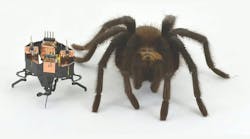Robots Typically Can’t Outrun Animals
What you’ll learn:
- What makes many animals run faster and better than robots or humans?
- Robots run faster than humans due to better agility, robustness, and range.
- Believe it or not, robot cockroaches can assist humanity.
Power density is a measure of how much power can be processed in any given space. It's quantifiable as the amount of power processed per unit of volume in units of watts per cubic meter (W/m3) or watts per cubic inch (W/in.3). In industrial automation, optimizing parameters and rising-edge dead time can help minimize losses and improve power density.
In the power density realm, this article explains why animals are far better at running than robots.
Two rudimentary mechanical properties are thought to characterize each unit of muscle mass as a motor: its maximum work density and its maximum power density.
Performance differences come into play with agility, robustness, and range. We must understand the underlying causes leading to the performance gap. Let’s compare artificial and natural technologies within five critical subsystems for running: power, frame, actuation, sensing, and control.
Typically, engineering technologies will meet or exceed the performance of their biological counterparts.
Biology has an advantage over engineering, which arises from better integration of subsystems. Now we can identify four fundamental obstacles that roboticists need to overcome. On this front, we highlight promising research areas with outsized potential that will help future running robots achieve an animal-level performance.
In essence, animals outperform robots in terms of legged locomotion. Many decades of research have produced a rich robot ecosystem with biocompatible designs.
Here, we use the broad phrase “runner” when referring to animals and robots that can use irregular interval contact between their limbs and terrain as they move. “Running” will also refer to the corresponding behavior, regardless of whether it would be more accurate to describe such behavior as walking or jumping. So, why are most animals able to run faster than robots?
>>Download the PDF of this article
Many animal species are able to outrun a human runner. And, of course, biological and engineered runners are built quite differently. Robots are assembled by humans and machinery from discrete components at the macroscale, while animals are naturally formed from diverse structures grown at the nanoscale.
Most Animals Can Outrun Robots
Who could win a foot race between a robot and an animal?
To address that question, a team of engineers in the United States and Canada, including University of Colorado Boulder roboticist and assistant professor, Kaushik Jayaram analyzed data from dozens of studies.
The answer was a resounding "no." In pretty much every case, biological organisms, such as cheetahs, cockroaches, and even human animals, endeavored to outrun their robot counterparts.
“As an engineer, it is kind of upsetting,” said Jayaram. “Over 200 years of intense engineering, we’ve been able to send spacecraft to the Moon and Mars and so much more. But it’s confounding that we do not yet have robots that are significantly better than biological systems at locomotion in natural environments.”
Jayaram wants the study to inspire engineers to learn to build far better, adaptable, and nimble robots.
Researchers have concluded that the failure of robots, which can’t outrun animals, doesn’t come down to shortfalls in any one piece of machinery, like batteries or actuators. Instead, where engineers can falter is in making those parts work together far more efficiently.
Jayaram’s lab, on the CU Boulder campus, houses furry wolf spiders, which are about the size of a half dollar, along with creepy crawlers. The lab also designed a unique robot named mCLARI2 (see figure).
According to Jayaram, “Animals are, in some sense, the embodiment of this ultimate design principle—a system that functions well together.”
Another robot, the cockroach-inspired Harvard Ambulatory Micro Robot (HAMR), was half the length of its previous HAMR-VI, making it one of the tiniest and fastest in the world!
Jayaram commented that machines the size of HAMR would be capable of crawling into airplane engines or any other spaces where mechanics could never reach to conduct needed inspections. They may even perform surgeries on human patients in the future. He said, “I want to build robots that can get out of the lab and run around like bugs.”
The Cockroach is Misunderstood
As a youngster, I lived in an apartment house in the Bronx, N.Y. We all had cockroaches to contend with.
The ubiquitous American cockroach is known as the “Periplaneta americana.” This insect is one of the most appalling pests that has managed to crawl into robotic studies. However, it appears in the reaches of many homes.
Jayaram previously built a small robot called CRAM (Compression Resistant Articulated Mechanism). This palm-sized robot, created from poster board and polyester, was built with highly compressible, bendable legs that are quite fascinating, using mechanized components for speed. A plastic shield imitates the insect’s wings and its malleable outer layer covers the beast’s entire body. This amazing robot was made to perform in both confined and open spaces.
What if cockroaches could assist humanity (and what we can learn from them)?
The CRAM mimics one of the cockroach’s main signature talents—the ability to squeeze into very tight spaces. The versatile cockroach can execute this vanishing act by compressing its body from a half inch to one-tenth of an inch in under a second.
The cockroach robot can have possible life-saving applications, such as employing it in search-and-rescue situations. It would be able to squeeze through rubble to aid search-and-rescue workers looking for openings that lead the way to trapped victims.
Most people feel anything but disgust when they see a cockroach. The CRAM proves that we can learn quite a bit from one of the world’s most unique creatures.
References
1. “Why animals can outrun robots,” Science Robotics, Vol. 9, No. 89, April 24, 2024.
2. “Robots can't outrun animals (yet). A new study explores why,” Daniel Strain, University of Colorado at Boulder, April 29, 2024 .
3. “Beyond power limits: the kinetic energy capacity of skeletal muscle,” David Labonte, Natalie C. Holt, Theory & Modelling, October 18, 2024.
4. “Cockroach-inspired robots among the smallest, fastest ever,” CU Boulder Today, June 3, 2020
5. “Cockroaches traverse crevices, crawl rapidly in confined spaces, and inspire a soft, legged robot,” Kaushik Jayaram and Robert J. Full, February 8, 2016
6. “Meet CRAM: The Advanced Robotic Cockroach, evolving science,” Intelligent Machines, April 12, 2017.
7. “Cockroaches inspire life-saving robots,” Eugene Pang, Berkeley, Industrial Engineering & Operations Research, College of Engineering, February 12, 2016.
8. “Cockroach inspires robot that squishes down to crawl through cracks and crevices,” Michael Franco, February 9, 2016.
9. Animal Inspired Movement and Robotics Laboratory (AIM-RL), University of Colorado Boulder, October 31, 2023.
>>Download the PDF of this article
About the Author

Steve Taranovich
Freelance Technical Writer, Phoenix Information Communication LLC
Steve is a contributing editor to Electronic Design.
Author of the non-fiction “Guardians of the Right Stuff,” a true story of the Apollo program as told by NASA and Grumman Corp. engineers, an astronaut, and technicians.
Experienced Editor-In-Chief of EETimes/Planet Analog and Senior Technical Editor at EDN running the Analog and Power Management Design Centers from 2012 to 2019.
A demonstrated history in electronic circuit design and applications for 40 years, and nine years of technical writing and editing in industry. Skilled in Analog Electronics, Space-related Electronics, Audio, RF & Communications, Power Management, Electrical Engineering, and Integrated Circuits (IC).
1972 to 1988 worked as a circuit design engineer in audio (8 years) and microwave (8 years). Then was Corporate Account Manager/applications engineer for Burr-Brown from 1988 to 2000 when TI purchased Burr-Brown. Worked for TI from 2000 to 2011.
Strong media and communication professional with a BEEE from NYU Engineering in 1972 and an MSEE from Polytechnic University in 1989. Senior Lifetime member of IEEE. Former IEEE Long Island, NY Director of Educational Activities. Eta Kappa Nu EE honor society member since 1970.


